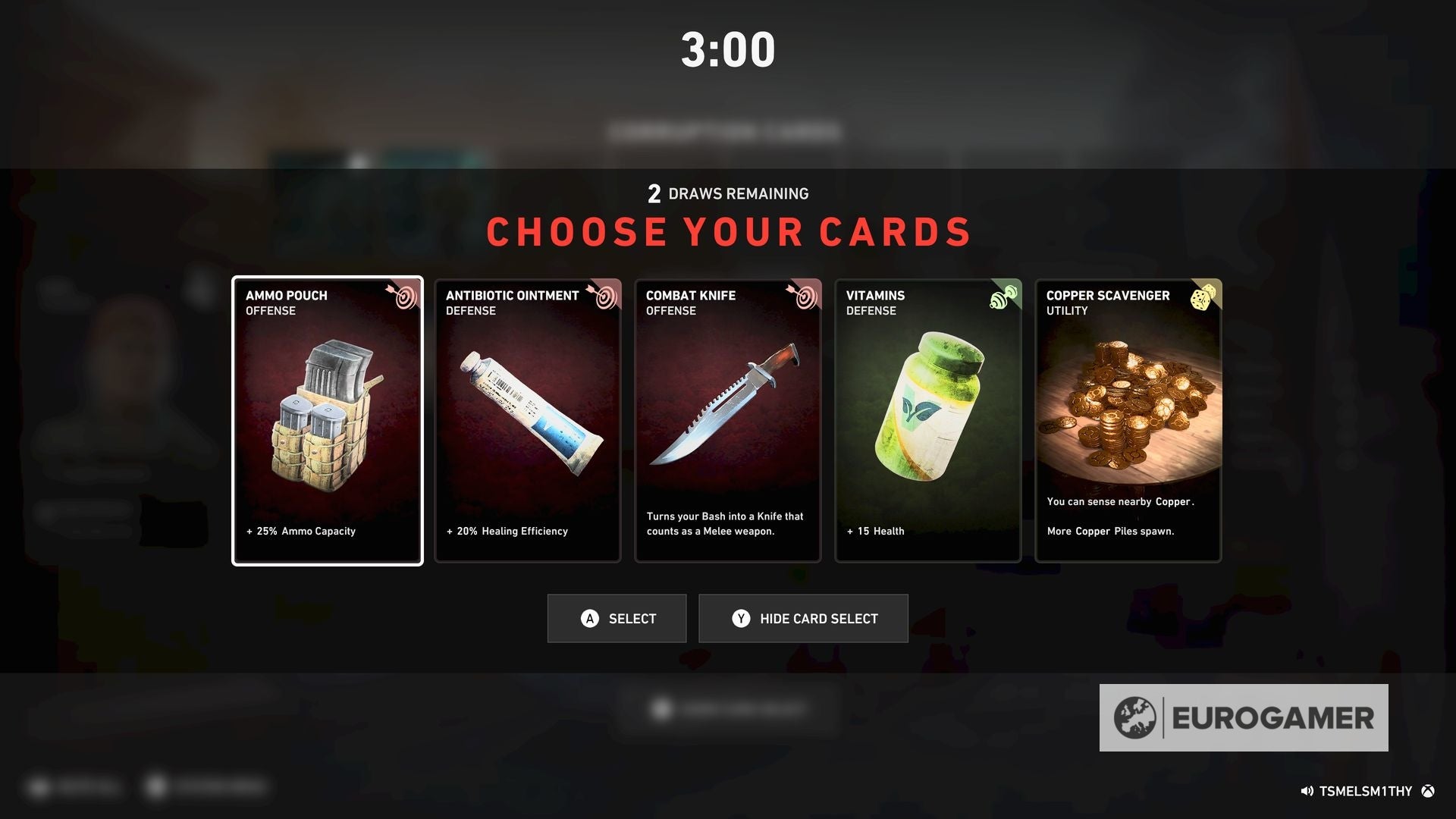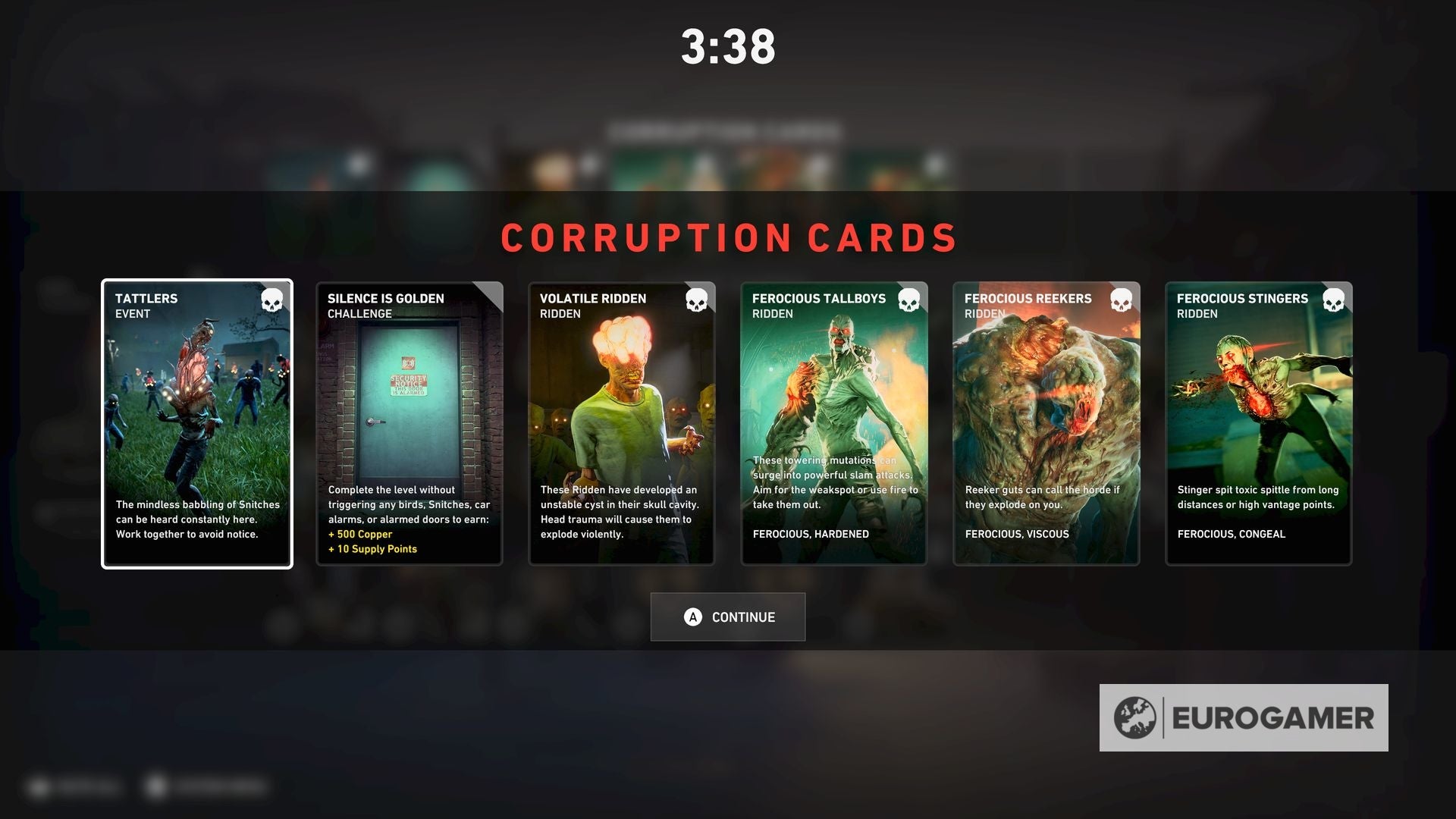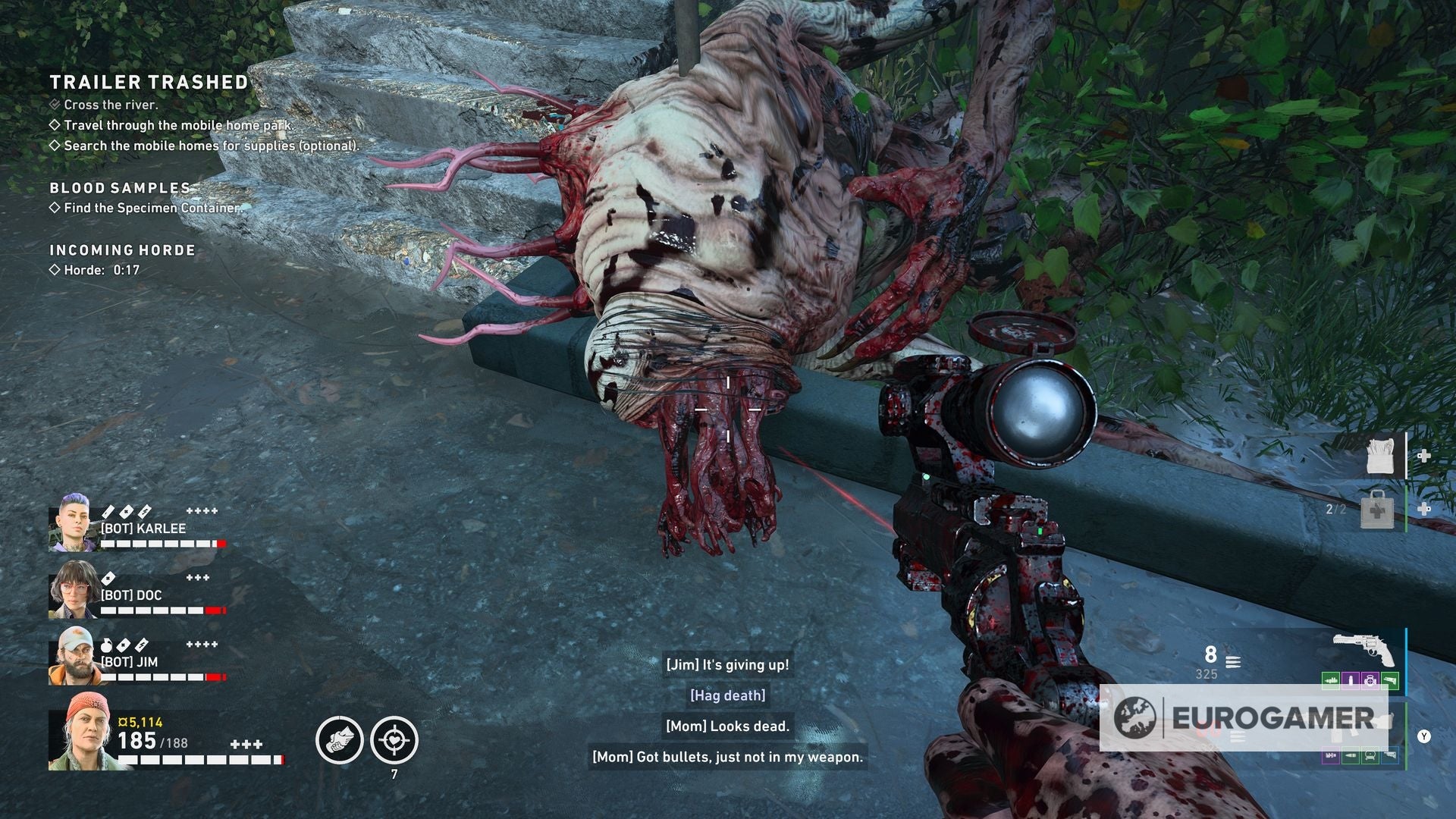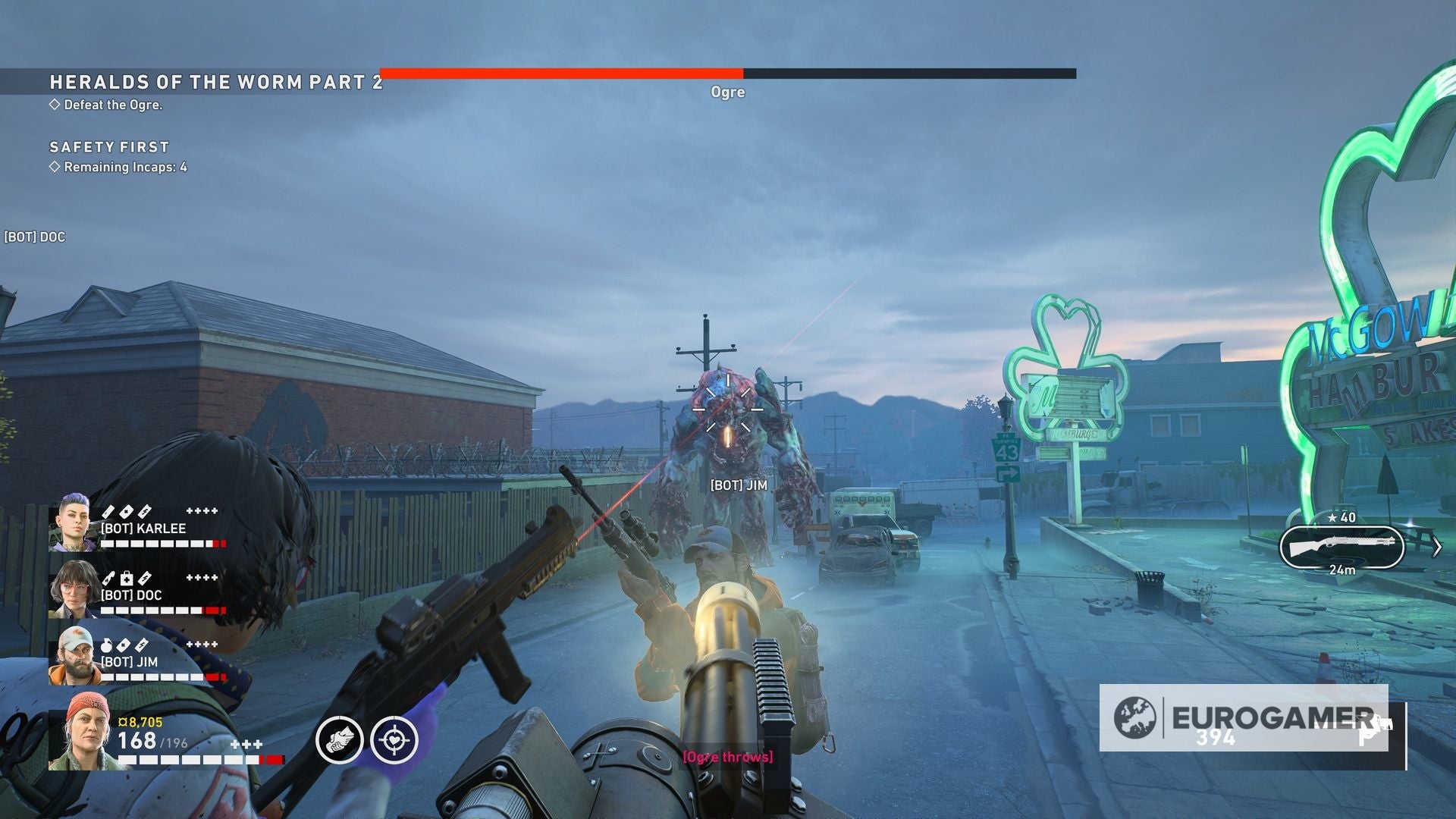But, actually, thankfully, it’s more than that. Scrabbling around in the game’s oddly enticing dark for long enough has allowed me to admit I was very much wrong. Back 4 Blood is interesting. It is unfamiliar, in places. It is good! Really good. Much of this comes down to its system of runs. As you may well know by now, Back 4 Blood is a close spiritual successor to Left 4 Dead, being developed by original Left 4 Dead studio Turtle Rock - once known as Valve South, during the Left 4 Dead years, before it was re-founded in 2011 again by some key names like Michael Booth, Phil Robb and Chris Ashton - and the history here is important. Left 4 Dead was not really a game you played through just once, but aside from the general morishness of the co-op it wasn’t necessarily built that way. Back 4 Blood is also a game you play through more than once, but this time it is built that way. The concept of multiple runs, then, is pretty important, and you can see how the game, odd as it may be up close, is very much built out from that point. There’s one core campaign to Back 4 Blood, which is PvE and absolutely designed for co-op. You can play it solo, but there’ll always be a group of four going through the campaign, so the other three in your party will be bots - surprisingly competent bots, actually - if you want to be completely alone, or you can roll the dice and matchmake with random strangers online (one of them usually a child, for that authentic 360-era experience). Or, you can of course play with friends - and a combination of bots or randoms too. The good news is the mission progression carries across, so if your mates suddenly abandon you halfway through a run you can start a new solo run from the last mission you reached should you so wish, and vice versa if they want to join halfway through. Where the whole “run” thing comes in is how this campaign system is structured. There are three difficulties to choose from when you start a run, which ramp up quite dramatically from super laid-back breeze to absolute, apocalyptic carnage. To be able to get anywhere in the middle or top difficulty levels you will need both a good build, and a good team - which is where the other part of the system comes in. Completing a campaign mission with any online companions - not, somewhat controversially, if you’re playing solo with bots - will award you an in-game currency supply points. Supply points can be spent to unlock progression along “supply lines”, which are effectively just skill trees. The progression grants you cards - which are very useful, interesting, and important - or occasionally some dreadful, pointless cosmetics - I’m talking, like, a beanie - which are not. Those cards all have some kind of unique perk to them, starting out with something basic like +15 health, and gradually getting more specialised and complex, like a card that grants dramatic increases to reload speed, but at the cost of being unable to ever aim down sights. You pick fifteen of the cards you’ve unlocked so far to form a deck, and then you pick a deck to use when you start a new run. Between each level, five cards from your deck are drawn - crucially, in order from how you assembled it - and you choose one of those at a time to go into your active build. This is combined with the “horde” having a deck of its own, where several random modifiers are added to the level. The effect is, initially, a somewhat lame system of randomisation - until suddenly it isn’t. What allows this system to work is having enough cards to actually build an interesting deck in the first place, and this is why it’s been so controversial that you don’t get supply points from playing solo - it means you can’t unlock new cards, so you’re stuck with an incredibly tame, low-difficulty horde game that changes at random as you play through it and offers, through the impossible difficulty of playing higher levels without co-ordinated teammates and specialised cards, no reason whatsoever to return for another go round. If you don’t play solo, and you do stick with the game through that somewhat bland initial run as you gradually build out your choice of cards, things get dramatically more rewarding. It’s possible to build hyper-specialised decks that get you to a point of being completely “broken” - which is secretly the fun of any casual game with builds in it anyway. I’ve barely scratched the surface myself, but already seen some - melee in particular - that become truly ridiculous, combining your character’s unique traits with stacking stamina buffs, speed boosts, and team-wide painkilling whenever you you scythe down a zombie (which you will do, maybe a thousand times, on higher difficulties). All of this combines with what is, at times, some extremely fun level design that’s geared towards the exaggerated joy that ought to be at the heart of any half-decent zombie game. One particularly frenetic, tower-defense-like level near the start of the campaign has you distract a massive horde by holding out in a bar that’s full of essentials - namely barbed wire and molotovs and piles of ammo - while blasting out punk-pop tunes from a jukebox that you must defend from zombies’ perpetual attention. Another finishes with an up-hill “gauntlet” through a residential area, as piles upon piles of enemies launch themselves over the once-idyllic picket fences either side of you. Another has you ascend a mine where they just plain fall out of the ceiling. Pelting it through these to the saferoom, giggling deliriously over the mic, covered head to toe in guts and mud and other unspeakable muck, spraying wildly with, say, a souped-up LMG with massively extended magazines in your hands and a cheeky little machine pistol in reserve, is just an utter, utter delight. The same goes for much of the PvP, which is a briefer, arguably even more casual mode. I forgot how good this was in the original Left 4 Dead games, a guffawing, feet-up, half-asleep mode designed immaculately for the hours of 12 to 4am. It works broadly the same as the originals - a team of humans versus a team of zombies, then you swap - the slight twists here being little modifiers added to the levels, so rather than a simple game of cat-and-mouse it’s more of a hold out as long as you can siege against the horde, or a frantic, run-and-gun runaround as a battle royale-like bubble of lethal insects (or whatever) closes in around you. Across both campaign and PvP are also a few more enemy types, which helps. There are three core ones: a big “tall boy” zombie that takes a fair bit of damage and whacks you with a big arm; an agile, stealthy one that spits and jumps and grabs; and a giant, exploding one that again is prone to either gobbing on you from afar, or running up and exploding (just don’t call it a “boomer”, less you incur the wrath of the lawyers). Within those three are three little sub-classes each - tall boys that grab, not-boomers that stay at ranged distance, and so on - and they make for enough variety to mix it up in PvP, although they do still get a tad stale in the campaign. That there is the main issue, really. Things do get a touch repetitive and some enemy design isn’t as good as the rest. Bosses, for instance, are mostly quite uninspired: most are a Very Big Zombie, basically, that acts as a bullet sponge and knocks you around a bit. And I’m not in love with the entire horde deck system as a whole. Sometimes it throws up a kind of enhanced carnage, or one of the more interesting bosses (there is an absolutely vile “thing” called a Hag, which runs at you from a distance and snaffles up one of your teammates down some kind of worm-like face-hole before burrowing into the ground. The theme music for it is horrifying, as are its tiny little T-Rex arms, and it makes for a nice mix-up to the usual big boy enemies). Other times, though, it combines to make levels a real dirge. This can meddle quite miserably with the cards, as well. The whole point of that system is for you to plan in advance, but then you might arrive in a level, resplendent in your high-ammo, high-chaos LMG build, and find the enemy deck is forcing you into stealth: the level is full of alarm-like zombies that summon a horde - a huge wave of enemies - when triggered; and the lights are off everywhere; and there are alarmed doors everywhere; and there are tougher versions of enemies everywhere that need a few big hits to go down. And, maybe, a decent LMG just doesn’t turn up for a while, because weapons are randomised, aside from the also-randomised couple you can buy with a run-specific currency at the start of each level. (And maybe your random-stranger teammate is a bit of a zombie themselves, running head-first into those alarmed doors when your entire squad’s on next to no health - but don’t get me started.) All that stuff is a shame, and it couples with a general sense of clumsiness in places, the weirdness, for instance, of having a kind of “hub”, which is very 2015, and also totally superfluous: a place where you can physically walk around and get three words out of an NPC before entering a menu that you can already access by… opening the menu. And on the topic of NPCs, the game’s story seems to have gone completely AWOL, arriving in fits and starts as spurted out by some military guy while everyone scrabbles around buying new weapons before you start a round, but never really explaining itself, to the point where you just periodically tune in to the odd non-sequitur about blowing up a bridge or rescuing some guy, and dial straight back out. Fortunately, though, I do not play horde-based zombie shooters for their riveting narrative, and I suspect nobody else does either. And a bad roll of the level-modifier dice can, if you’re at the start of a run, at least, be dealt with by just quitting and starting a new one, as blunt a tool as that may be. Beyond that annoyance, the user experience side of things is actually excellent, from the cross-progression, to platform cross-play, to the fact that the runs have chapters that, when completed, allow you to duck out to the hub-slash-menu to unlock a few more cards and tinker with your decks before continuing, making the whole thing a kind-of-roguelite, but with kind-of-checkpoints. It’s almost there, basically. Almost really quite special. But in falling just short of that Back 4 Blood is still a wonderful, messy treat of a game. Considering it got there by effectively slapping a progression system on a widely-adored, cult-favourite series that might be best described as the video game equivalent to a bong, that’s quite an achievement, too.







